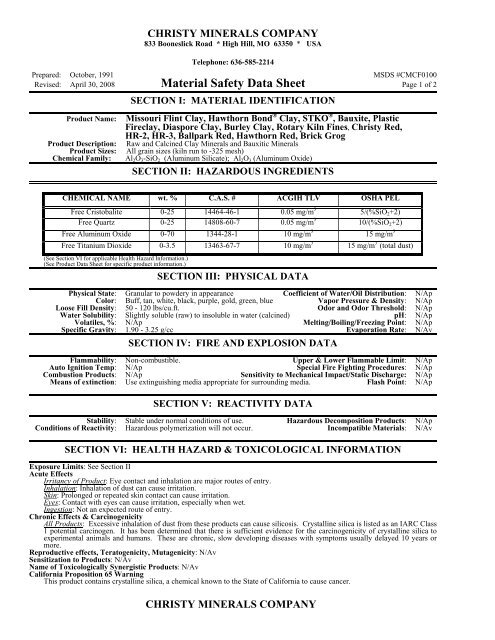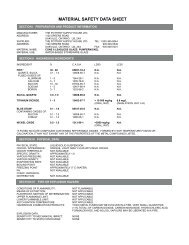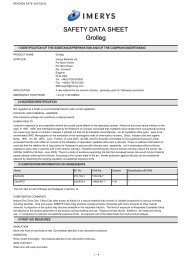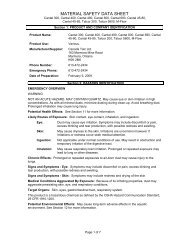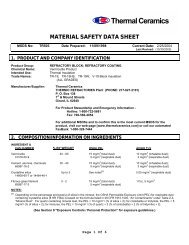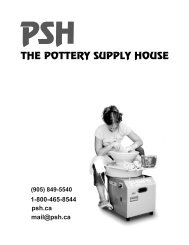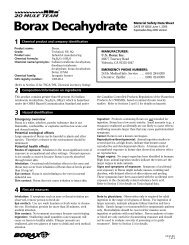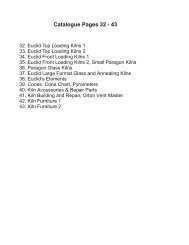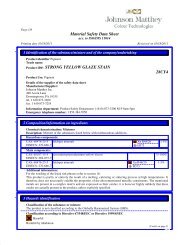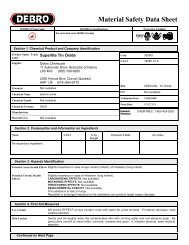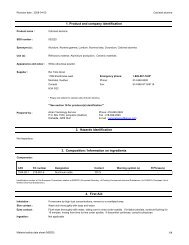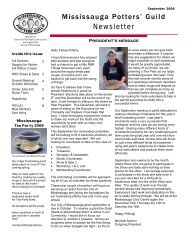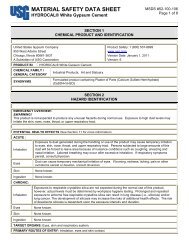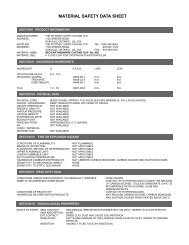Material Safety Data Sheet
Material Safety Data Sheet
Material Safety Data Sheet
You also want an ePaper? Increase the reach of your titles
YUMPU automatically turns print PDFs into web optimized ePapers that Google loves.
CHRISTY MINERALS COMPANY<br />
833 Booneslick Road * High Hill, MO 63350 * USA<br />
Telephone: 636-585-2214<br />
Prepared: October, 1991 MSDS #CMCF0100<br />
Revised: April 30, 2008 <strong>Material</strong> <strong>Safety</strong> <strong>Data</strong> <strong>Sheet</strong> Page 1 of 2<br />
SECTION I: MATERIAL IDENTIFICATION<br />
Product Name: Missouri Flint Clay, Hawthorn Bond ® Clay, STKO ® , Bauxite, Plastic<br />
Fireclay, Diaspore Clay, Burley Clay, Rotary Kiln Fines, Christy Red,<br />
HR-2, HR-3, Ballpark Red, Hawthorn Red, Brick Grog<br />
Product Description: Raw and Calcined Clay Minerals and Bauxitic Minerals<br />
Product Sizes: All grain sizes (kiln run to -325 mesh)<br />
Chemical Family: Al2O 3-SiO 2 (Aluminum Silicate); Al 2O 3 (Aluminum Oxide)<br />
SECTION II: HAZARDOUS INGREDIENTS<br />
CHEMICAL NAME wt. % C.A.S. # ACGIH TLV OSHA PEL<br />
Free Cristobalite 0-25 14464-46-1 0.05 mg/m 3<br />
Free Quartz 0-25 14808-60-7 0.05 mg/m 3<br />
Free Aluminum Oxide 0-70 1344-28-1 10 mg/m 3<br />
Free Titanium Dioxide 0-3.5 13463-67-7 10 mg/m 3<br />
(See Section VI for applicable Health Hazard Information.)<br />
(See Product <strong>Data</strong> <strong>Sheet</strong> for specific product information.)<br />
SECTION III: PHYSICAL DATA<br />
5/(%SiO2+2) 10/(%SiO2+2) 15 mg/m 3<br />
15 mg/m 3 (total dust)<br />
Physical State: Granular to powdery in appearance Coefficient of Water/Oil Distribution: N/Ap<br />
Color: Buff, tan, white, black, purple, gold, green, blue Vapor Pressure & Density: N/Ap<br />
Loose Fill Density: 50 - 120 lbs/cu.ft. Odor and Odor Threshold: N/Ap<br />
Water Solubility: Slightly soluble (raw) to insoluble in water (calcined) pH: N/Ap<br />
Volatiles, %: N/Ap Melting/Boiling/Freezing Point: N/Ap<br />
Specific Gravity: 1.90 - 3.25 g/cc Evaporation Rate: N/Av<br />
SECTION IV: FIRE AND EXPLOSION DATA<br />
Flammability: Non-combustible. Upper & Lower Flammable Limit: N/Ap<br />
Auto Ignition Temp: N/Ap Special Fire Fighting Procedures: N/Ap<br />
Combustion Products: N/Ap Sensitivity to Mechanical Impact/Static Discharge: N/Ap<br />
Means of extinction: Use extinguishing media appropriate for surrounding media. Flash Point: N/Ap<br />
SECTION V: REACTIVITY DATA<br />
Stability: Stable under normal conditions of use. Hazardous Decomposition Products: N/Ap<br />
Conditions of Reactivity: Hazardous polymerization will not occur. Incompatible <strong>Material</strong>s: N/Av<br />
SECTION VI: HEALTH HAZARD & TOXICOLOGICAL INFORMATION<br />
Exposure Limits: See Section II<br />
Acute Effects<br />
Irritancy of Product: Eye contact and inhalation are major routes of entry.<br />
Inhalation: Inhalation of dust can cause irritation.<br />
Skin: Prolonged or repeated skin contact can cause irritation.<br />
Eyes: Contact with eyes can cause irritation, especially when wet.<br />
Ingestion: Not an expected route of entry.<br />
Chronic Effects & Carcinogenicity<br />
All Products: Excessive inhalation of dust from these products can cause silicosis. Crystalline silica is listed as an IARC Class<br />
1 potential carcinogen. It has been determined that there is sufficient evidence for the carcinogenicity of crystalline silica to<br />
experimental animals and humans. These are chronic, slow developing diseases with symptoms usually delayed 10 years or<br />
more.<br />
Reproductive effects, Teratogenicity, Mutagenicity: N/Av<br />
Sensitization to Products: N/Av<br />
Name of Toxicologically Synergistic Products: N/Av<br />
California Proposition 65 Warning<br />
This product contains crystalline silica, a chemical known to the State of California to cause cancer.<br />
CHRISTY MINERALS COMPANY
833 Booneslick Road * High Hill, MO 63350 * USA<br />
Telephone: 636-585-2214<br />
Prepared: October, 1991 MSDS #CMCF0100<br />
Revised: April 30, 2008 <strong>Material</strong> <strong>Safety</strong> <strong>Data</strong> <strong>Sheet</strong> Page 2 of 2<br />
SECTION VII: SPILL, LEAK & DISPOSAL PROCEDURES<br />
Spill & Leak: Clean-up personnel need a NIOSH respirator approved for lung damaging dusts. Sweep spills and vacuum where<br />
necessary. Avoid generating dust.<br />
Disposal: Dispose of waste in an approved landfill in accordance with federal, state, and local laws.<br />
SECTION VIII: FIRST AID & SPECIAL PROTECTION INFORMATION<br />
First Aid<br />
Inhalation: Move victim to fresh air. If breathing difficulty continues, give oxygen & obtain medical help.<br />
Skin Contact: Wash with soap and warm water. If irritation develops, consult a physician.<br />
Eye Contact: Flush with water for at least 15 minutes. Call physician if irritation persists.<br />
Ingestion: If ingested, do not induce vomiting. Obtain medical attention.<br />
Respiratory Protection: Provide adequate general ventilation. Provide workers with NIOSH respirators approved for lung<br />
damaging dusts when exposed to dust. Exposure levels over 100 times TLV (Section II) require air supplied respirators.<br />
Skin & Eye Protection: Gloves and safety goggles should be worn when exposed to excessive dust.<br />
Ventilation: Provide local exhaust ventilation to meet exposure limits (Section II).<br />
SECTION IX: SPECIAL PRECAUTIONS<br />
Handling: Dust in the work area should be kept to a minimum and proper ventilation provided. Avoid inhalation of dust. Avoid<br />
eye contact with materials.<br />
Storage: No special storage conditions are required.<br />
Shipping: No special shipping information is required.<br />
SECTION X: ABBREVIATIONS & REFERENCES<br />
Abbreviations<br />
N/Av: not available<br />
N/Ap: not applicable<br />
IARC: International Agency for Research on Cancer<br />
ACGIH: American Conference of Governmental Industrial Hygienists<br />
TLV/TWA: Threshold Limit Values/Time Weighted Average<br />
NIOSH: National Institute of Occupational <strong>Safety</strong> and Health<br />
References<br />
1. ACGIH, Threshold Limit Values and Biological Exposure Indices for 2003<br />
2. International Agency for Research on Cancer Monographs, Volume 68, 1996<br />
3. Canadian Centre for Occupational Health and <strong>Safety</strong>. Trade name <strong>Data</strong>base.<br />
4. <strong>Material</strong> <strong>Safety</strong> <strong>Data</strong> <strong>Sheet</strong>s of raw materials.<br />
5. N. Irving Sax. Dangerous Properties of Industrial <strong>Material</strong>s. Seventh Edition.<br />
6. Business & Legal Reports, Inc.- Book of Chemical Lists, April 1997<br />
The information and recommendations set forth herein are presented in good faith and believed to be correct as of the date of this MSDS. Christy<br />
Minerals Company makes no representations as to the completeness or accuracy thereof, and information is supplied upon the express condition<br />
that the persons receiving same will be required to make their own determination as to the suitability for their purposes of use. In no event will<br />
Christy Minerals Company be responsible for any damages of any nature whatsoever resulting from the use of, reliance upon, or the misuse of this<br />
information.<br />
This information is supplied simply to be informative and to alert the user of the material. The ultimate compliance with federal, state, and/or local<br />
regulations concerning the use of this material, or compliance with respects to products liability, rest solely upon the purchaser thereof.


